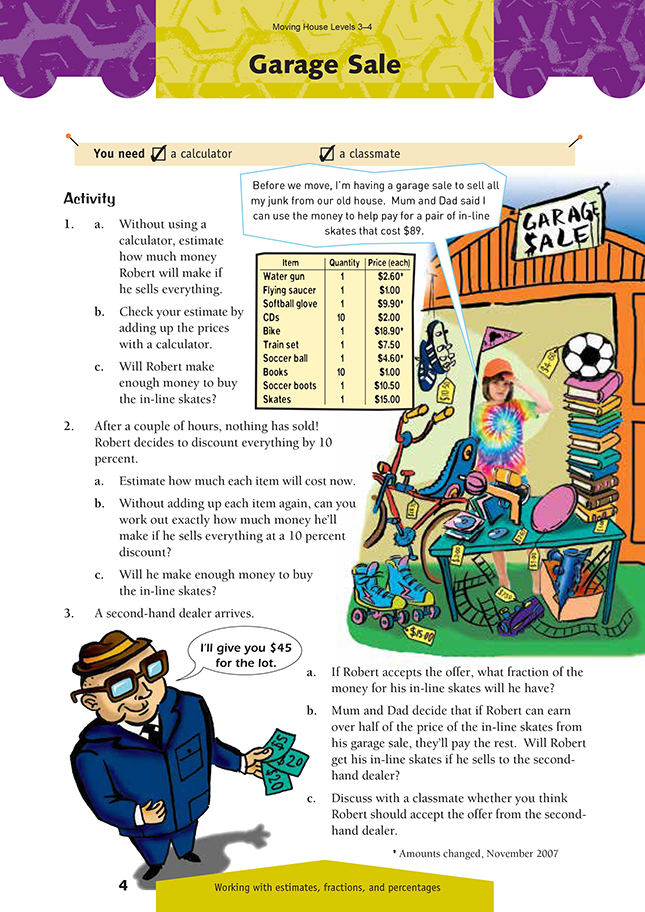This is a level 3 and 4 number activity from the Figure It Out theme series.
A PDF of the student activity is available.
Click on the image to enlarge it. Click again to close. Download PDF (341 KB)
round money amounts and estimate a total
find 10% of money amounts
FIO, Levels 3-4, Theme: Moving House, Garage Sale, page 4
A calculator
A classmate
Estimation is an extremely important mathematical skill, but students often have trouble with the concept behind it. An estimate is an approximation that is close enough to the actual value to give a good idea of its size, but which is easier to work with. Estimates are often used in quick mental calculations that would be too difficult with the original numbers.
What is “close enough” depends on the size of the number you are approximating. Saying that there were 35 000 people at a rugby match is likely to be an acceptable estimate even if it is wrong by two or three thousand. In other situations, however, an estimate that is out by two or three thousand is completely unacceptable (for example, saying that there were 4 000 people at an exhibition when there were only 1 000).
Students need to understand these ideas:
• When asked for an estimate, there is no one right answer, though there is often a best answer ($20 is the best estimate for $19.95).
• The estimate must point towards the actual amount, not away from it ($10 is not an acceptable estimate for $17.95).
• The range of acceptable estimates is proportional to the number being approximated. An estimate is normally within about 10 percent of the actual value, although there is no rule that stipulates this.
Before the students estimate the totals in question 1, discuss with them how they might go about it.
Should they just consider the dollar amounts? Should they round up or down? What method might give the closest estimate? Give them plenty of examples for practice. Supermarket dockets are a ready source of real-life numbers for which students could estimate totals. (Blank out the actual totals first.)
Question 2 is about percentages and estimates. Ask the students what 10 percent means (one-tenth or 10 parts out of 100) before asking them to estimate what 10 percent of each item is. Discuss with them the idea of rounding the amounts before estimating, for example, rounding $9.95 to $10. Then 10 percent off $10 gives $9, which is a much easier calculation.
Question 3. Before the students reach for their calculators, encourage them to look at the numbers and see that $45 is approximately half of $89.
As a further investigation, the students could look at the sales advertisements of retail stores. What do tickets like these mean: “Up to 50% off”, “5 to 50% off everything”, “15% off”, “At least 10% off”?
Answers to Activities
1. a. About $100. Estimates will vary.
b. $100
c. Yes, if he sells most things.
2. a. Suggested estimates of the prices discounted
by 10% are:
Water gun: between $2.20 and $2.50
Flying saucer: $0.90
Softball glove: $9
CDs: $1.80 each
Bike: $17
Train set: $7
Soccer ball: between $4 and $4.20
Books $0.90 each
Soccer boots: between $9 and $9.50
Skates: $13.50
Remember, some estimates are better than others, but there is no one “right” estimate. However, unless the estimate gives a fair idea of the correct amount, it is not good enough. Where the calculation is very simple, the estimate and the actual answer may be the same.
b. Take 10% off the original total of $100 to get $90.
c. $90 is greater than $89, so he will have enough.
3. a. 45/89
b. Yes, $45 is over half of $89.
c. Answers will vary and need not be written down.
